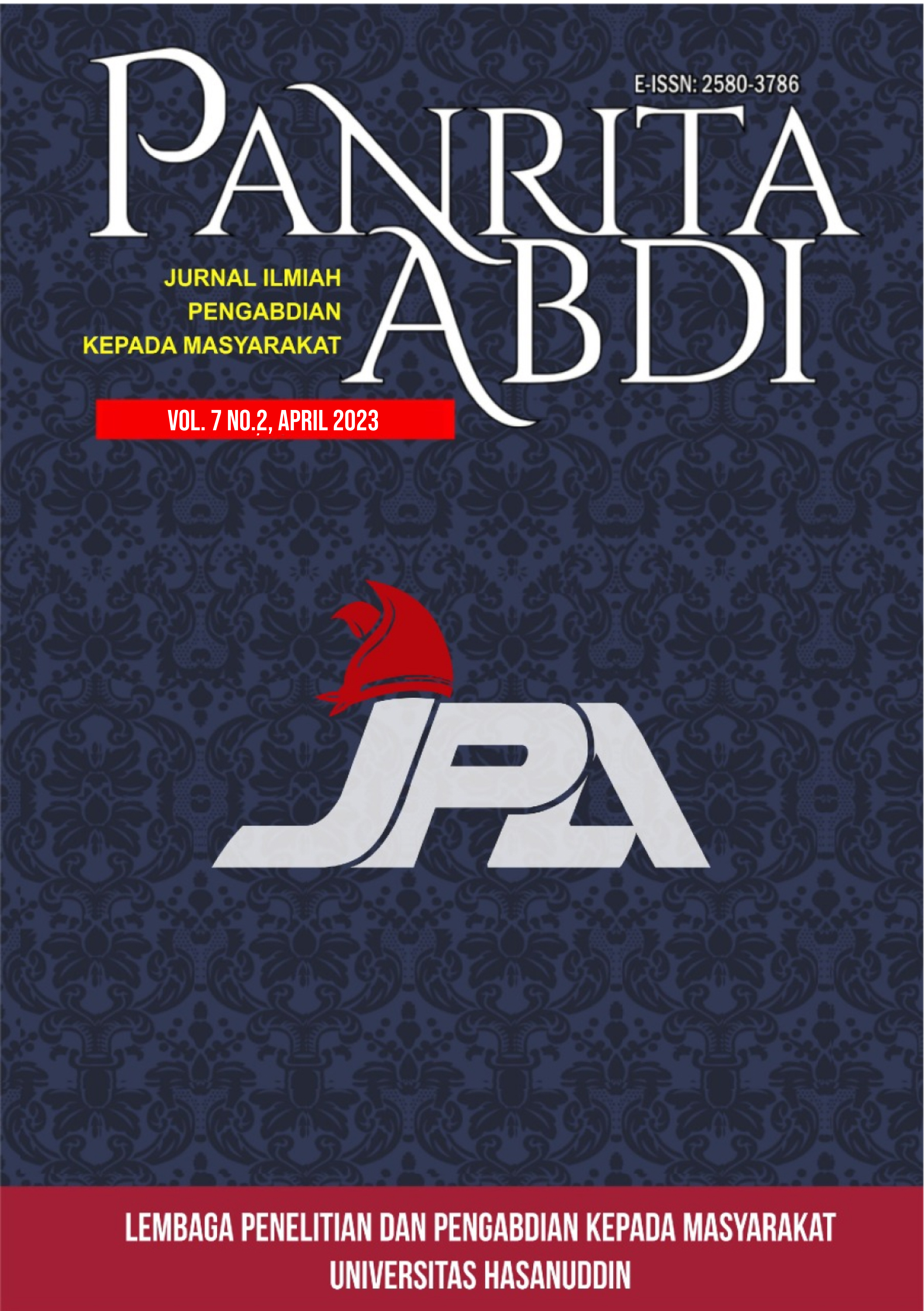PEMANFAATAN LIMBAH PADAT SEREH WANGI SEBAGAI BAHAN BAKU BIOARANG UNTUK PERBAIKAN TANAH
DOI:
https://doi.org/10.20956/pa.v7i2.18864Keywords:
Waste, biomass, citronella, biochar, pyrolysisAbstract
The waste from the distillation of citronella oil in KM 6 Village, Simpang Keuramat District, has yet to be appropriately utilized. The distillation business can process 1.6-2 tons of fragrant lemongrass leaves in a day. If the oil content of fragrant lemongrass leaves is 0.5%-1.5%, then the waste produced can reach 1.5-2 tons in a day. Debris that has accumulated is usually burned openly. The smoke from this combustion process has an impact on air pollution. In addition, ash from burning also pollutes river water. This service aims to reduce air and river water pollution from the wrong waste treatment process by utilizing the waste as biochar. This biochar will then be used to increase soil nutrients. To ensure biochar quality, combustion is carried out through a pyrolysis process so that the charcoal produced is more significant and produces liquid smoke as a by-product. This service activity is implemented by providing counseling and demonstrations demonstrating the process of processing citronella waste into biochar so that the resulting biochar product can benefit the surrounding community and be safe for the environment. The community understood the importance of good waste management from discussions and demonstrations at this service activity. All participants understood the procedures for managing biomass waste, especially citronella waste, into biochar with 80% understanding. --- Limbah hasil penyulingan minyak sereh wangi di Desa KM 6 Kecamatan Simpang Keuramat sampai saat ini masih belum mampu diberdayakan dengan baik. Dalam sehari usaha penyulingan tersebut mampu mengolah daun sereh wangi sebanyak 1,6-2 ton, jika kadungan minyak pada daun sereh wangi adalah 0,5%-1,5% maka dalam sehari limbah yang dihasilkan mampu mecapai 1,5-2 ton. Limbah yang telah menumpuk biasanya dibakar secara terbuka. Asap dari proses pembakaran ini berdampak pada pencemaran udara. Selain itu abu dari hasil pembakaran juga mencemari air sungai. Pengabdian ini bertujuan untuk mengurangi pencemaran udara dan pencemaran air sungai dari proses pengolahan limbah yang salah dengan memanfaatkan limbah tersebut sebagai bioarang. Bioarang ini selajutnya akan digunakan untuk meningkatkan unsur hara tanah. Untuk menjamin kualitas bioarang pembakaran dilakukan melalui proses pirolisis sehingga jumlah bioarang yang dihasilkan lebih banyak dan juga menghasilkan asap cair sebagai produk sampingan. Pelaksanaan kegiatan pengabdian ini dilakukan dengan memberikan penyuluhan dan demonstrasi proses pengolahan limbah sereh wangi menjadi bioarang, sehingga produk bioarang yang dihasilkan dapat bermanfaat bagi masyarakat sekitar dan aman bagi lingkungan. Dari penyuluhan dan demontrasi pada kegiatan pengabdian ini masyarakat memahami pentingnya pengelolaan limbah dengan baik dan semua peserta telah mengerti tatacara mengelola limbah biomassa khususnya sereh wangi menjadi biorang dengan penguasaan ≥80%.
References
Afzal, A., Munir, A., Ghafoor, A., & Alvarado, J. L. (2017). Development of hybrid solar distillation system for essential oil extraction. Renewable Energy. https://doi.org/10.1016/j.renene.2017.05.027.
Arribas, M. P., Soro, P., & Silvestre, J. F. (2013). Allergic Contact Dermatitis to Fragrances : Part 2 ଝ. 104(1), 29–37.
Basu, P. (2013). Chp. 05: Pyrolysis. In Biomass Gasification, Pyrolysis and Torrefaction. https://doi.org/10.1016/B978-0-12-812992-0/00005-4.
Becidan, M. (2007). Experimental Studies on Municipal Solid Waste and Biomass Pyrolysis. In PhD Thesis (Issue May).
Beneti, S. C., Rosset, E., Corazza, M. L., Frizzo, C. D., Di, M., & Oliveira, J. V. (2011). Fractionation of citronella ( Cymbopogon winterianus ) essential oil and concentrated orange oil phase by batch vacuum distillation. Journal of Food Engineering, 102(4), 348–354. https://doi.org/10.1016/j.jfoodeng. 2010.09.011.
Bertella, A., Benlahcen, K., Abouamama, S., Pinto, D. C. G. A., Maamar, K., Kihal, M., & Silva, A. M. S. (2018). Industrial Crops & Products Artemisia herba-alba Asso . essential oil antibacterial activity and acute toxicity. Industrial Crops & Products, 116(October 2017), 137–143. https://doi.org/10.1016/ j.indcrop.2018.02.064.
Cai, W., Luo, Z., Zhou, J., & Wang, Q. (2021). A review on the selection of raw materials and reactors for biomass fast pyrolysis in China. Fuel Processing Technology, 221(106919), 1–14. https://doi.org/https://doi.org/10.1016/ j.fuproc.2021.106919.
Fitria, L., Fitrianingsih, Y., & Jumiati, J. (2020). Penerapan Teknologi Penanaman Mangrove Di Kabupaten Mempawah Provinsi Kalimantan Barat, Indonesia. Panrita Abdi - Jurnal Pengabdian Pada Masyarakat, 4(2), 126–135. https://doi.org/10.20956/pa.v4i2.7613.
Rimantas, P., & Baranauskien, R. (2006). Properties of oregano ( Origanum vulgare L .), citronella ( Cymbopogon nardus G .) and marjoram ( Majorana hortensis L .) flavors encapsulated into milk protein-based matrices. 39, 413–425. https://doi.org/10.1016/j.foodres.2005.09.005.
Setiawan, A., Hayat, F., Faisal, & Nur, T. B. (2019). Combustion characteristics of densified bio-char produced from Gayo Arabica coffee-pulp: Effect of binder. IOP Conference Series: Earth and Environmental Science, 364(1). https://doi.org/10.1088/1755-1315/364/1/012007.
Setiawan, A., Anshar, K., Zulnazri, & Subhan. (2021). Pengaruh Penerapan Manajemen Penjadwalan Terhadap Laju Produksi Minyak Sereh Wangi. Jurnal Panrita Abdi, 5(4), 619–626.
Xu, C. C., Liao, B., Pang, S., Nazari, L., Mahmood, N., Tushar, M. S. H. K., Dutta, A., & Ray, M. B. (2018). Biomass Energy. Comprehensive Energy Systems, 1–5, 770–794. https://doi.org/10.1016/B978-0-12-809597-3.00121-8.
Yen, H. Y., & Lin, Y. C. (2017). Industrial Crops & Products Green extraction of Cymbopogon citrus essential oil by solar energy. Industrial Crops & Products, 108(June), 716–721. https://doi.org/10.1016/j.indcrop.2017.07.039
Downloads
Published
How to Cite
Issue
Section
License
Copyright (c) 2023 Syamsul Bahri, Khairul Anshar, Adi Setiawan, Zainuddin Ginting

This work is licensed under a Creative Commons Attribution-NonCommercial-NoDerivatives 4.0 International License.











